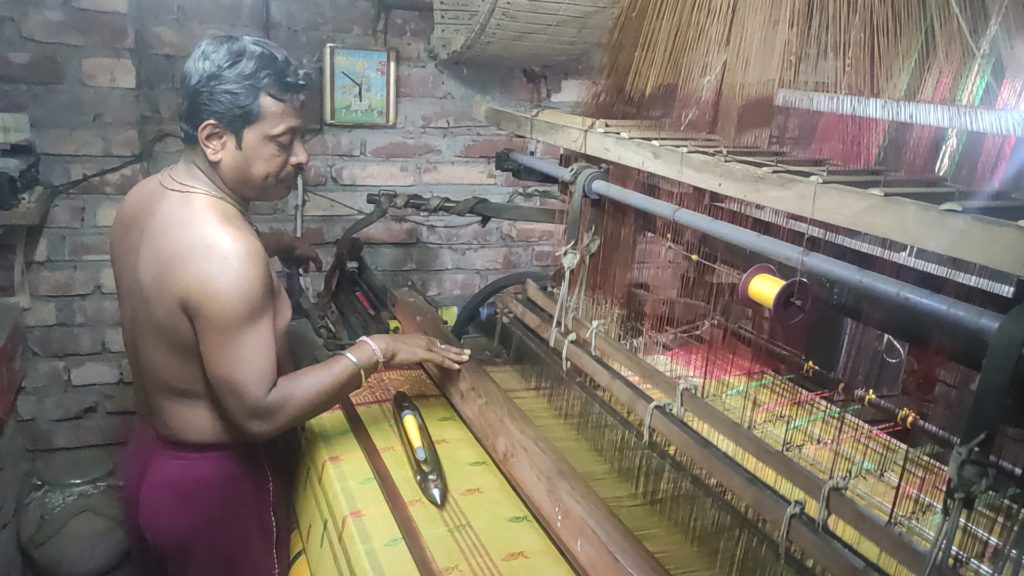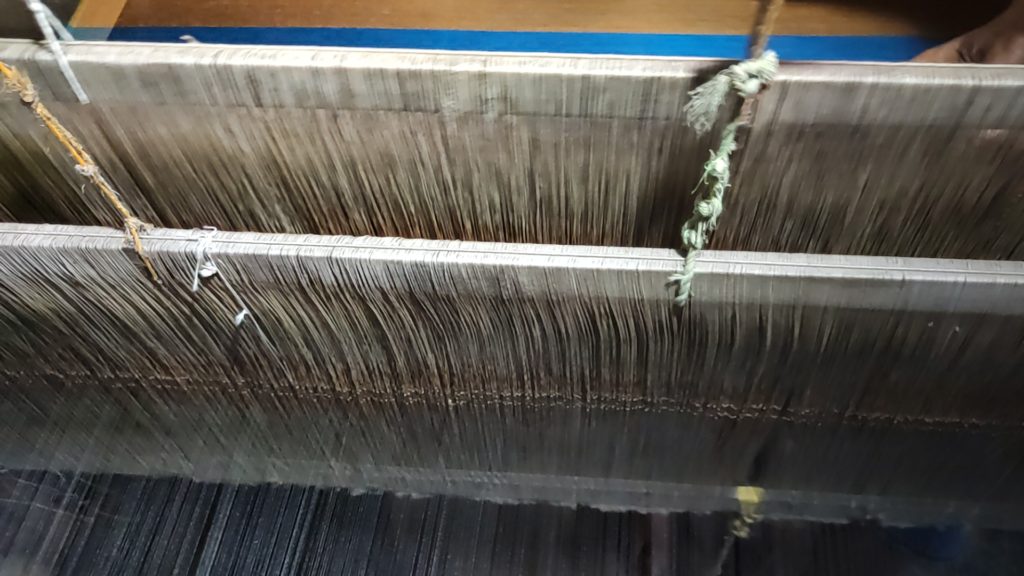Weavers of Shantipur in West Bengal wrapped up in gloom
There was a time Shantipur was abuzz with music of the jacquard looms on which the renowned tant saris were woven. But, one after the other, these looms are falling silent. The beleaguered handloom weavers, who just casted their ballot in the West Bengal polls, fear the Shantipur weave will perish along with them.

Shantipur, West Bengal
The looms in Santipur are falling silent one by one. Perhaps, the last of the once-famous tant (handloom) saris are being woven. “We will soon be history,” Dilip Nandi, who has woven countless Santipur saris in his life, told Gaon Connection. The 70-year-old is very likely part of the last generation of the weavers that is still holding aloft a 500-year-old weaving tradition in the district of Nadia in West Bengal.
When the Partition happened in 1947, many weavers from present day Bangladesh, crossed over to West Bengal and set up looms in Shantipur and neighbouring Phulia. Soon Shantipur, located around 100 kilometres from Kolkata, and Phulia became the hub of the cotton tant (handloom) saris.
But the buzz of a thriving weaving town is now almost lost. Weavers who used to weave bold and vibrant red, yellow and deep blue saris with their decorative borders and pallus, and often with small butis (leaf-like motifs) on them, are no more sought after, like they were once across the world.

“Over a lakh [100,000] weavers were present in Shantipur and Phulia. Now there are only about 60,000 of them,” Biswanath Deb, a weaver in Shantipur told Gaon Connection.
Also Read: A village that thrived on handloom, Cooch Behar’s Baburhat now has only one handloom mill
But 60,000 votes are worth fighting for and the down-at-heel Shantipur has become one of the closely fought constituencies in the state. Ajay De of the ruling Trinamool Congress (TMC) and Jagannath Sarkar of Bharatiya Janata Party (BJP) have thrown their hats into the ring as Nadia district went to poll last Saturday on April 17. The eight-phase West Bengal Assembly Election comes to a close on April 29 and the results will be declared on May 2.
Both the political parties have promised to improve the condition of the weavers if they vote for them.
“Our government (TMC) has done a lot for the weavers. Mamata Di, [the chief minister] is concerned about them,” Sanat Chakraborty, Trade Union leader of Trinamool Congress, based in Krishnanagar, Nadia district, said. “We have already given free handlooms to poor weavers to earn their livelihood and the government will come up with more schemes for them after the polls,” he promised.
Also Read: The unmarried girl and other stories from a village in election-bound West Bengal
The BJP is also offering largess to the beleaguered weavers. “We are planning to make a hub at Shantipur to connect weavers with buyers and eliminate the middlemen. It will help them increase their income,” Sumanta Halder, BJP youth leader, Shantipur township, told Gaon Connection. “We are also trying to connect them to different pension schemes to ensure a livelihood to aged weavers,” he claimed.

Weavers of Shantipur
The history of handloom saris in Shantipur can be traced back to the 15th century. It received royal patronage from the Mughals thereafter. The craft still survives, though barely. The British forced the farmers to cultivate not the traditional cotton that was woven into these saris, but another variety better suited to the mechanised textile mills back home in England.
Also Read: Bringing the desi back into cotton
After having faced so many adversities and yet carried on for so many centuries, the handloom weavers are now weary. They face competition from powerlooms and synthetic saris, and their returns for their work of art are pitiful. Weaving has also taken a physical toll on them. Their eyes hurt and they are plagued by ailments, they say. There is little energy or hope and they know they are the last of their kind.
“My sons are already working in a private company and have no interest in this work. Once we move to our graves, there will be no more music from the jacquard looms in Shantipur,” sighed Nandi, visibly sad.

The 66-year-old Biswanath Deb reiterated that the younger generation was not interested in weaving as they found they earned much better incomes working other jobs than they did weaving where after extreme toil they would just get a handful of rupees. “We get just about hundred rupees for every sari we weave and each sari takes us a day and a half to finish. We cannot weave more than two to three saris a week,” said Deb. It is difficult to survive on the paltry income, said the weaver who once had five handlooms but is left with only one now.
Meanwhile, weavers, both handloom and powerloom ones, continue to struggle and the pandemic has only worsened their plight, “Earlier, we used to get around hundred and twenty rupees a sari, but we get no more than seventy rupees now,” Bapi Nandi, a 36-year-old weaver who set up a powerloom at a cost of Rs 85,000, told Gaon Connection. “The future is bleak,” said the despairing weaver. The handloom Shantipur saris are priced upward of Rs 300 each, while the powerloom ones cost about Rs 200 per sari.
Bleak times
While a decline in the handloom saris has been blamed on the advent of the powerlooms, clearly, things are gloomy for powerloom weavers too.
Thirty-six-year-old Gourang Nandi hardly has the time to speak as he rushes to meet a deadline. But, he pauses long enough to tell Gaon Connection that powerloom weavers are having it rough as well. “We may be weaving five saris a day unlike handloom weavers who normally weave just one sari in a day and a half. But, we are paid just Rs 70 per sari that takes normally two to three hours to make,” he explained.
A powerloom weaver has to weave at least five saris a day to break even. If he does that he will earn about Rs 350 a day, but has to pay for power and labour out of that. “The income is barely enough to run our livelihood. And, the work is also irregular as the demand for Shantipur saris is dwindling,” Gourang Nandi said.

According to him the mahajans (merchants) have informed them that people do not prefer cotton saris anymore. The mahanjans provide weavers with raw material and collect the finished product and sell them to whole-sellers.
“The reason behind falling demand is increasing competition from synthetic clothes while weavers here still work on cotton threads,” Uttam Sadhukhan, a merchant told Gaon Connection. Cotton saris cost almost double what synthetic saris do, he also pointed out. “Till about four to five years ago, our production was a thousand saris a month which has dwindled to just about two hundred. We have never seen such bad days before,” he said.
But not all feel so pessimistic. “The handloom weavers are a vanishing lot but power looms are not doing too badly. The wages have been low due to the impact of lockdown but it will soon return to normal,” Tarak Das, joint secretary, Nadia district Chamber of Commerce assured Gaon Connection. He pointed out that the powerloom weavers were still managing to earn about Rs 350 a day which was not bad in the present circumstances. Das also does wholesale trading of cotton saris.
Meanwhile, as Shantipur goes to the polls, its electorate is not very hopeful of any miracles that will change in their living conditions. They are far too accustomed to grandiose promises made to them that are never kept. Their craft and business have been going downhill steadily for years now, they say. But no political party has stepped up to offer them a helping hand. Why should this time be any different, they ask.
Also Read: Betrayed by the ballot: The hijra community of North Bengal

